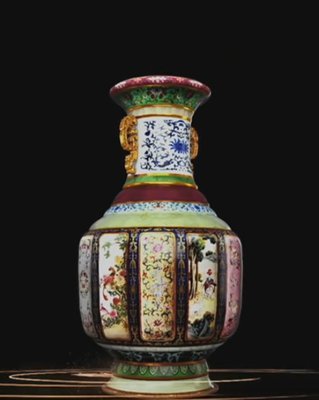
The Qing Dynasty "Mother of Porcelain" vase (Photo/CCTV.com)
After poem-reciting and letter-reading shows became huge hits in China, a new show focusing on museums and ancient relics is looking to take advantage of Chinese viewers' growing interest in traditional culture.
Currently holding a rating of 9.5/10 on Chinese review platform Douban, National Treasure quickly rose to the top of the country's national television rating ranks as well as the trending charts on Sina Weibo after it debuted on Sunday on the State-run China Central Television (CCTV).
"Innovative," "informative" and "fun" were the most frequently used words to describe the show on China's social media platforms.
The show focuses on introducing the stories and history surrounding 27 rare antiques from nine key museums in China, but introduces a reality show twist as ultimately nine treasures will be chosen via audience vote to take part in an exhibition at the Palace Museum in Beijing in 2020 celebrating the 600th anniversary of the Forbidden City.
Having fun with history
Through stage plays featuring famous stars and presentations by experts, National Treasure seems to be aiming to be more than just Chinese Relics 101.
Renowned actors Li Chen, Wang Kai and Tony Leung respectively play Emperor Huizong of the Song Dynasty (960-1279), the Qianlong Emperor of the Qing Dynasty (1644-1911) and Sima Guang, a Song Dynasty scholar - key figures in the stories of the first three treasures explored in the show's first episode.
This effort to make history entertaining has paid off. The show has taken streaming site bilibili.com by storm with some 530,000 views and 620,000 comments so far.
Nicknamed B Station, the platform has long been a major home to China's 25 and under population obsessed with the ACG (Anime, Comic and Games) culture and foreign films and shows.
"Love the visuals at the beginning. I've rewatched that part over and over!" commented one viewer, "I had tears in my eyes as I watched the show," wrote another.
"It portrays the story behind each national treasure like a blockbuster movie might do," Jiang Song, a member of the Chinese Museums Association, told the Global Times on Wednesday, explaining why he feels the show has been such a big hit among young viewers.
"National Treasure brings museums and relics to young people in a playful and informative way."
This is not the first time that a cultural series has become so popular overnight on the site. According to Jiang, the success of cultural documentaries such as Masters of the Forbidden City and In Search of Craftsmanship reflect a growing interest in traditional culture among China's youth.
Diverse representations
Though star power might be an important element for attracting young viewers, it is the treasures themselves that are the main focus.
The first three stories covered on the show involve Emperor Huizong and his student Wang Ximeng's 11.9-meter-long landscape painting A Panorama of Rivers and Mountains, the Qianlong Emperor and the largest colored porcelain vase produced during his reign, and Sima Guang and the Qin Dynasty (221BC-206BC) Stone Drums, 10 valuable drum-shaped stones featuring inscriptions written in a form of ancient Chinese script.
"It is an amazing show that does a good job combining knowledge and entertainment," Zhang Lin (pseudonym), an employee from the publicity office of a Beijing-based archaeological institution who is also a fan of the show, told the Global Times on Wednesday.
The story of the Qianlong vase has been regarded by many Chinese netizens as the highlight of the show so far. Screenshots and footage from this part of the show quickly became viral memes after the premiere.
In the show, the Qing emperor has a dream in which long-dead ancient artists and even his deceased father, the Yongzheng Emperor, criticize his obsession with bright colors and complicated designs. The emperor justifies himself saying that this is the best way to showcase the prosperity of his reign.
Upon awakening, the emperor orders a huge 86 centimeter-tall vase incorporating various colors and patterns - later nicknamed the "Mother of Porcelain" - be made using all 17 ceramic making techniques that had been passed down through the ages.
While some netizens pointed out that this is just the show's interpretation as to why the emperor had such gaudy taste, Zheng Hong, an associate researcher at the Palace Museum, thinks the show got it right.
"I agree with the perspective that he intended to epitomize the techniques used throughout the history as a way to show off his power," she told the Global Times on Wednesday.
Zheng also noted that the complicated patterns and bright colors used during his reign reflect his ethnic background, Zheng explained.
"As Manchu descendant, he was always proud of his heritage. He paid more attention to developing Manchu culture while his grandpa and father focused more on promoting Han culture," Zheng said.


















































